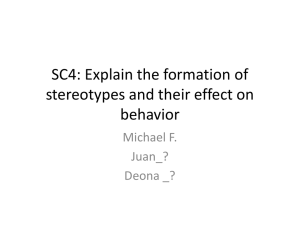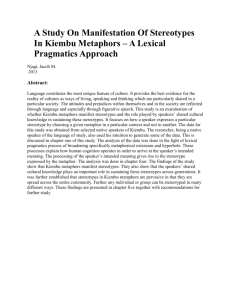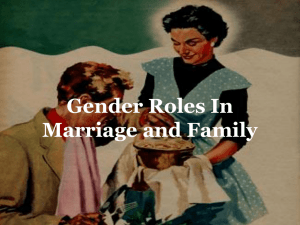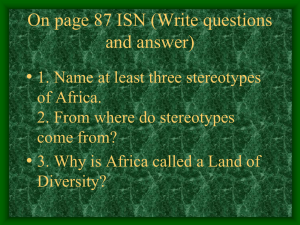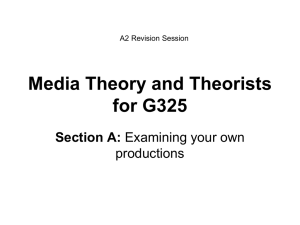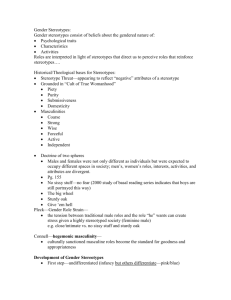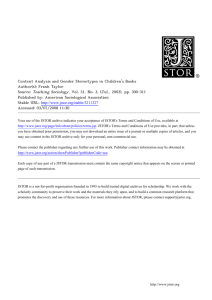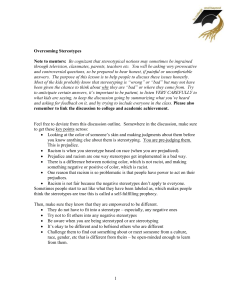Sociology Final Paper
advertisement
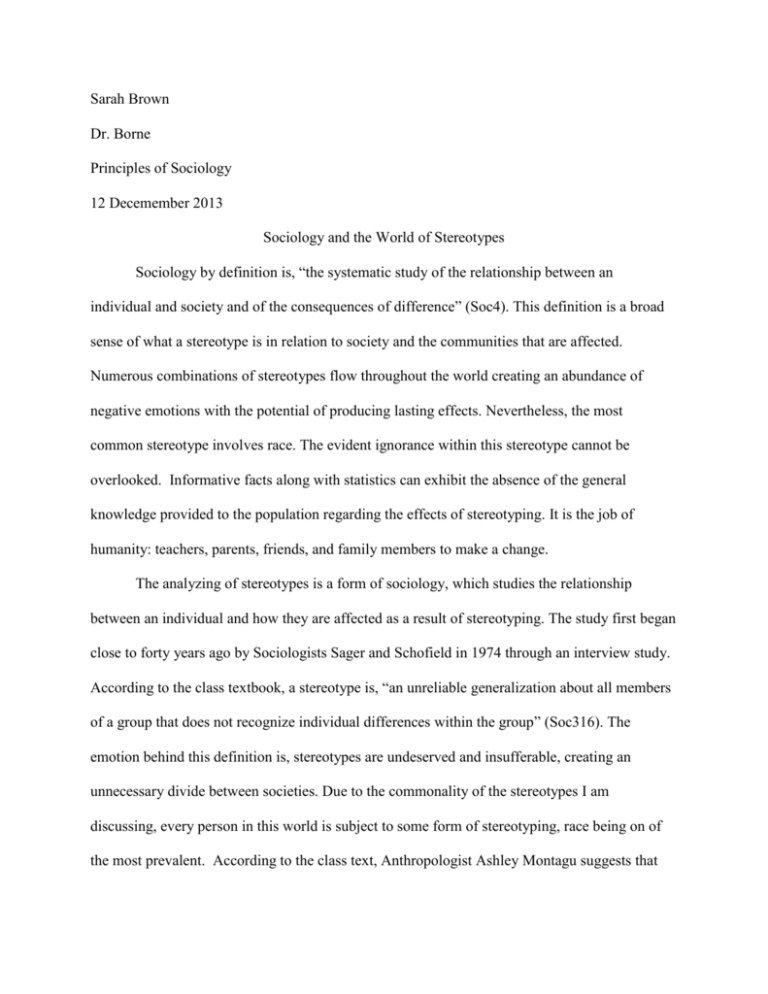
Sarah Brown Dr. Borne Principles of Sociology 12 Decemember 2013 Sociology and the World of Stereotypes Sociology by definition is, “the systematic study of the relationship between an individual and society and of the consequences of difference” (Soc4). This definition is a broad sense of what a stereotype is in relation to society and the communities that are affected. Numerous combinations of stereotypes flow throughout the world creating an abundance of negative emotions with the potential of producing lasting effects. Nevertheless, the most common stereotype involves race. The evident ignorance within this stereotype cannot be overlooked. Informative facts along with statistics can exhibit the absence of the general knowledge provided to the population regarding the effects of stereotyping. It is the job of humanity: teachers, parents, friends, and family members to make a change. The analyzing of stereotypes is a form of sociology, which studies the relationship between an individual and how they are affected as a result of stereotyping. The study first began close to forty years ago by Sociologists Sager and Schofield in 1974 through an interview study. According to the class textbook, a stereotype is, “an unreliable generalization about all members of a group that does not recognize individual differences within the group” (Soc316). The emotion behind this definition is, stereotypes are undeserved and insufferable, creating an unnecessary divide between societies. Due to the commonality of the stereotypes I am discussing, every person in this world is subject to some form of stereotyping, race being on of the most prevalent. According to the class text, Anthropologist Ashley Montagu suggests that the very word “race” is racist. Ashley believes that through implying the existence of significantly biological differences populations render others to being inferior. Consequently this statement showcases the very root of the problem, which is the human instinct to attempt the understanding of uniqueness towards another and shy away from the unfamiliarity generating hate due to the lack of knowledge. Stereotypes regarding race are generally the most prevalent simply because the difference in skin tone is physically the most distinguishing characteristic among the population. The differentiation between races within American is believed by many to stem from the horrendous century of slavery. During the time of slavery, equality was far from visible toward the African American people. This particular point in American history produces mixed emotions demonstrating the beliefs of some who still encourage the separation among “blacks and whites.” The author of the volume Phylon, James R. Hayes displays the racial stereotype formed within this belief is the “impression” that America’s forefathers were socially correct when they instituted the right to own slaves. The question can then be asked regarding the abolishment of slavery: why did the mindset not change when the law did? Many “racists” trust in the idea of inherent limitations, which is the belief that African Americans will always be considered an inferior race (Hayes330). Statistics aid the belief of white superiority over various races, one of which being African Americans. Racial stereotypes are usually created due to an unfortunate experience generated by an individual of a different race. Furthermore, stereotypes can also be spread vocally from person to person with no particular experience or reason demonstrated. Through my research I arrived at a study based entirely off of the statistics of African Americans, which were taken over of the course of four generations. The most recent generation’s statistics (1992) read: 84% of African Americans are superstitious, 75% lazy, 38% ignorant, 26% musical and 24% religious. These statistics are misleading on multiple occasions one in being the ability to calculate ignorance. The material provided is far from reliable due to the lack of factual information and research. These flawed statistics filter directly into the class text, More Damned Lies and Statistics regarding the shortage of evidence and knowledge. More Damned Lies and Statistics illustrates the harms of trusting statistics as a whole. Joel Best; the author of the book, vindicates the specific purpose of statistics, which is to “promote causes, create fear, and advance particular points of view.” The United States is a population thriving off of the demand for gossip and commotion. This demand creates a commonality for many individuals to allow their gullible tendencies’ develop control over the ability to distinguish truth from stereotype. As previously stated, stereotypes are unreliable generalizations, but what makes them unreliable? The lack of both knowledge and education is to blame for the inappropriate generalizations made in which produce stereotypes. In Chapter 5 of The Tipping Point, the author informs the reader that in order for a new trend to remain and prosper, large populations must embrace it. Regarding this logic, stereotypes could potentially perish due to an increase in knowledge pertaining to morality, and a decrease in bliss found within hatred. Morals according to Dictionary.com are “standards of behaviors or beliefs’ concerning what is and what is not expectable.” If more people were educated regarding the negative affects stereotypes have on the victims, a means of prevention could be created. Throughout the world millions of people fall victim to stereotyping which creates a divide within humanity. For most it seems impossible to refrain from passing judgments upon another’s clothes, hair, make-up, etc., however a person cannot shed their skin color as if it were and old outfit. An individuals skin tone is their God given race and it should always be treated as such. Works Cited Best, Joel. More Damned Lies and Statistics: How Numbers Confuse Public Issues. Berkeley: University of California, 2004. Print. "The Definition of Morality." (Stanford Encyclopedia of Philosophy). Web. 09 May 2012. <http://plato.stanford.edu/entries/morality-definition/>. Gladwell, Malcolm. The Tipping Point: How Little Things Can Make a Big Difference. Boston: Little, Brown, 2000. Print. Hayes, James R. JSTOR. Web. 09 May 2012. <http://www.jstor.org/discover/10.2307/274248?uid=3739664>. ""Stereotypes and Generalities"" "Stereotypes and Generalities" Web. 09 May 2012. <http://www.uakron.edu/president/co_12_13_03PM.php>. Witt, Jon, and Jon Witt. SOC. New York: McGraw-Hill, 2012. Print.

